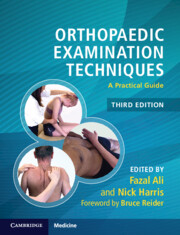Book contents
- Orthopaedic Examination Techniques
- Orthopaedic Examination Techniques
- Copyright page
- Dedication
- Contents
- Contributors
- Preface to 3rd edition
- Foreword to 2nd edition
- Foreword to 3rd edition
- Acknowledgements
- About the authors
- Chapter 1 General Principles of Orthopaedic Clinical Examination
- Chapter 2 Examination of the Shoulder
- Chapter 3 Examination of the Elbow
- Chapter 4 Examination of the Wrist
- Chapter 5 Examination of the Hand
- Chapter 6 Examination of the Peripheral Nerves in the Hand and Upper Limb
- Chapter 7 Examination of the Adult Spine
- Chapter 8 Examination of the Hip
- Chapter 9 Examination of the Knee
- Chapter 10 Examination of the Foot and Ankle
- Chapter 11 Examination of the Brachial Plexus
- Chapter 12 Orthopaedic Examination Techniques in Children
- Chapter 13 Examination of the Spine in Childhood
- Chapter 14 Paediatric Clinical Cases
- Chapter 15 Spine Clinical Cases
- Chapter 16 Upper Limb Clinical Cases
- Chapter 17 Lower Limb Clinical Cases
- Chapter 18 Orthopaedic Cases in the Developing World
- Index
- References
Chapter 11 - Examination of the Brachial Plexus
Published online by Cambridge University Press: 22 April 2022
- Orthopaedic Examination Techniques
- Orthopaedic Examination Techniques
- Copyright page
- Dedication
- Contents
- Contributors
- Preface to 3rd edition
- Foreword to 2nd edition
- Foreword to 3rd edition
- Acknowledgements
- About the authors
- Chapter 1 General Principles of Orthopaedic Clinical Examination
- Chapter 2 Examination of the Shoulder
- Chapter 3 Examination of the Elbow
- Chapter 4 Examination of the Wrist
- Chapter 5 Examination of the Hand
- Chapter 6 Examination of the Peripheral Nerves in the Hand and Upper Limb
- Chapter 7 Examination of the Adult Spine
- Chapter 8 Examination of the Hip
- Chapter 9 Examination of the Knee
- Chapter 10 Examination of the Foot and Ankle
- Chapter 11 Examination of the Brachial Plexus
- Chapter 12 Orthopaedic Examination Techniques in Children
- Chapter 13 Examination of the Spine in Childhood
- Chapter 14 Paediatric Clinical Cases
- Chapter 15 Spine Clinical Cases
- Chapter 16 Upper Limb Clinical Cases
- Chapter 17 Lower Limb Clinical Cases
- Chapter 18 Orthopaedic Cases in the Developing World
- Index
- References
Summary
Brachial plexus examination is described in a simple manner for this difficult topic. A drawing of the brachial plexus is included, which is essential knowledge for learning to examine the brachial plexus. The system is: look, feel, move.
Inspection includes looking for Horner’s syndrome, which may indicate a preganglionic lesion. Palpation is for the presence of the pulse, sweating and the sensory testing. Motor testing is in a sequential manner whereby the examiner tests the myotomes, the muscles supplied by the branches off the roots, the muscles supplied by the branches off the trunks, the muscles supplied by the branches off the cords and then the terminal branches of the brachial plexus.
Included in the chapter is a section on how clinical examination findings influence treatment and also a section on the obstetric brachial plexus.
- Type
- Chapter
- Information
- Orthopaedic Examination TechniquesA Practical Guide, pp. 193 - 212Publisher: Cambridge University PressPrint publication year: 2022

